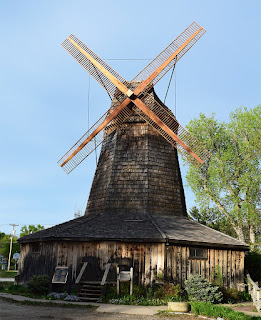The Old Dutch Mill: A Testament to Early Settlement in the Region and a Project of the National Youth Administration
 |
| Old Dutch Mill, Wagner Park, Smith Center, Kansas |
Wagner Park, Madison St. and 3rd St.
This old windmill, called the Old Dutch Mill, was an important tool for grinding grains harvested and consumed by early settlers to Smith County. Between 1879 and 1882, Charles G. Schwarz, an immigrant from Germany, constructed this mill on the north side of Reamsville, a small town that was located about 10 miles north and 4 miles west of Smith Center. The mill's blades, which were originally covered with cloth, powered the mill until 1914 when a kerosene engine was attached to the mill. The mill was used to grind corn, wheat, and other grains for nearly four decades, until 1920.
 |
| Old Dutch Mill in Reamsville in 1914. |
On February 3, 1938, with permission from the Schwarz family, the mill was moved to its present location in the city of Smith Center. The move was a project of the National Youth Administration, a New Deal program created by an executive order by President Franklin D. Roosevelt in June 1935. The National Youth Administration (NYA) was a program developed to help young men and women between the ages of 16 and 25 find work and a sense of belonging and self-worth during the Great Depression of the 1930s. The NYA participants gained work experience, skills, and knowledge which would benefit them as they transitioned to adulthood and to the world after the depression had waned. In this case, the NYA participants not only helped to rebuild the mill but they also helped create the city park (now Wagner Park) in which the mill was placed.
About seventeen years after the move to Smith Center, on March 16, 1955, a fire destroyed a significant part of the mill. Responding to the situation, several women in the community led an effort to raise money for the mill's repair. Over the next two months, residents, former residents, and people who had visited the mill or simply read about the mill donated about $2700 and the labor to repair the structure. By the beginning of June of that year, the mill was once again open to the public.
Today, people can rent the mill for gatherings or celebrations - the inside has a kitchen and a large open space for dances or for tables and chairs. The city attached a new set of blades to the mill in the early Spring of 2017.
You can see the short articles printed in Smith Center's newspapers about the mill's 1938 move to Wagner Park by clicking on the links below:
Comments
Post a Comment